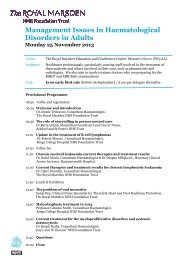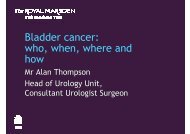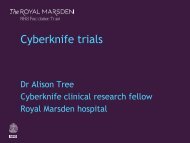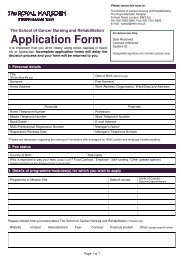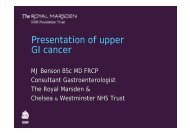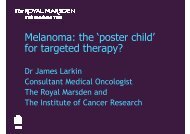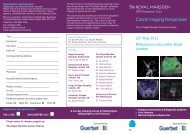Joint Annual Research Report 2004 - The Royal Marsden
Joint Annual Research Report 2004 - The Royal Marsden
Joint Annual Research Report 2004 - The Royal Marsden
You also want an ePaper? Increase the reach of your titles
YUMPU automatically turns print PDFs into web optimized ePapers that Google loves.
CANCER THERAPEUTICS<br />
Integrating new drugs into the<br />
clinical treatment strategy<br />
In these ever changing times we feel<br />
Chromosome 14 translocations<br />
Early<br />
Late<br />
t(4;14) FGFR3/MMSET<br />
t(8;14) MYC<br />
t(6;14) MUM1<br />
that it is important to integrate some of<br />
t(11;14) cyclin D1<br />
the newer drugs into clinical treatment<br />
strategies quickly. Drugs which have<br />
t(14;16) CMAF<br />
Immortalisation Independent growth of malignant plasma cell<br />
been shown to be effective in recent<br />
years such as thalidomide, bortezomib<br />
and lenolidamide are being integrated<br />
into our routine practice, but importantly<br />
we are also running a number of<br />
investigational protocols, based on<br />
Increasing genetic instability 13q- Activating mutations p53 and RAS<br />
laboratory data, combining these<br />
targeted drugs with standard<br />
chemotherapies to try and further improve<br />
Normal<br />
plasma cell<br />
MGUS Myeloma Plasma cell<br />
leukaemia<br />
response rates and remission durations.<br />
<strong>The</strong> future<br />
As part of our Phase I trial commitment we are also<br />
Figure 2.<br />
A molecular model of<br />
investigating the potential therapeutic effects of a We are making excellent progress in our understanding multiple myeloma.<br />
number of new drugs. Importantly, all of these have of the use of novel small molecule chemotherapeutic<br />
Models of myeloma are<br />
based on a clinically<br />
been shown to be effective in laboratory studies, but approaches and how to integrate advances in these defined multi-step<br />
pathogenesis, where a<br />
have not been tested previously in cancer patients. areas with standard treatments.<br />
normal plasma cell is<br />
<strong>The</strong>refore the emphasis of these trials is to investigate Over the next few years we expect to see significant<br />
envisaged to transform<br />
into a pre-malignant<br />
the drugs’ potential anti-myeloma effects, whilst closely advances in the quality of life and survival of patients stage (MGUS), which<br />
then transforms to<br />
monitoring for side effects. It is hoped that by<br />
with myeloma. Our combined clinical and laboratory myeloma. At the endstage<br />
performing trials such as this within the <strong>Royal</strong> <strong>Marsden</strong> organisation will directly facilitate the transition of new of the disease,<br />
these myeloma cells no<br />
that we can make quick and efficient steps forward in laboratory developments into the clinic, so that patients longer remain located<br />
within the bone marrow<br />
making useful and effective drugs more widely available can benefit at the earliest possible stage.<br />
and can now be found<br />
for patients.<br />
in the peripheral blood.<br />
<strong>The</strong> initiating events for<br />
myeloma are thought to<br />
involve chromosomal<br />
Modulating the<br />
translocations, whilst<br />
later events involve<br />
immune system<br />
mutations of either RAS<br />
or p53 oncogenes,<br />
together with other<br />
as yet ill-defined<br />
genetic lesions.<br />
We have shown that thalidomide can enhance the<br />
immune system – in particular natural killer (NK) cells<br />
– which work against the myeloma plasma cells. <strong>The</strong>se<br />
laboratory and targeted treatment approaches are<br />
complemented by our transplant programme, which is<br />
aimed at using dual autologous (ie same person) and<br />
mini-allogeneic (ie different people) transplants to both<br />
stabilise the malignant clone and then to introduce<br />
donor T-cells in an environment where it is possible to<br />
benefit from the graft versus myeloma effect. This T-cell<br />
immunomodulation is relevant clinically and provides a<br />
way of safely performing an allogeneic transplant in<br />
older patients.<br />
We firmly anticipate<br />
that myeloma will<br />
become a chronic<br />
disease, which can be<br />
managed long-term<br />
without impacting<br />
significantly on the<br />
quality of life of patients.<br />
37






